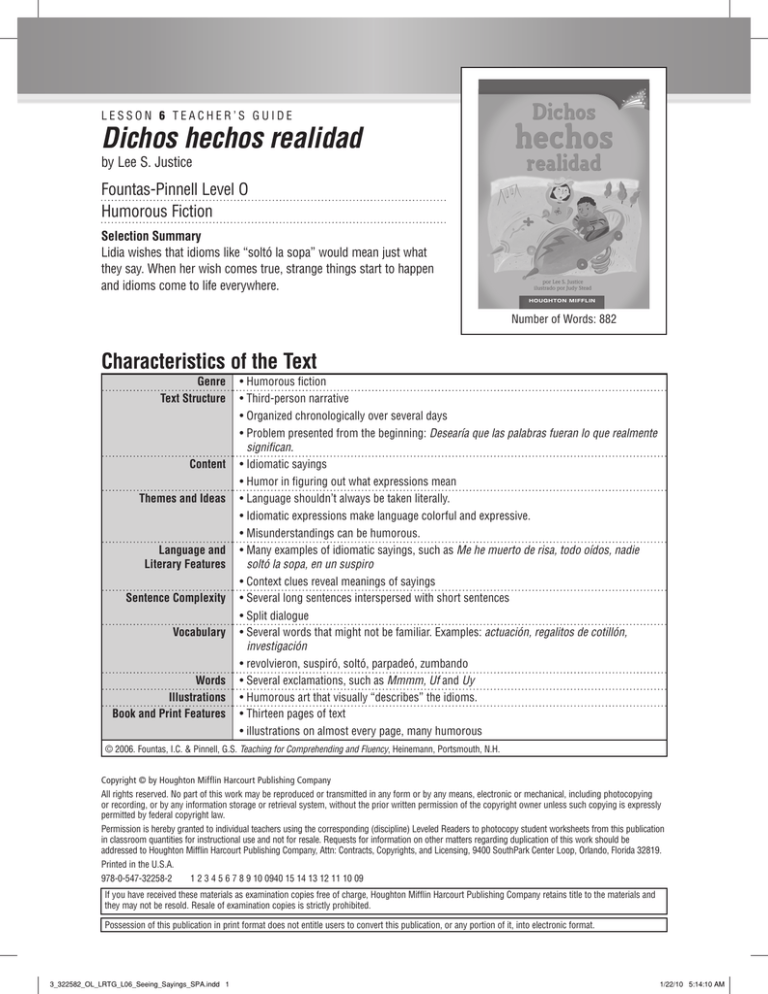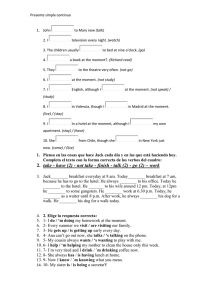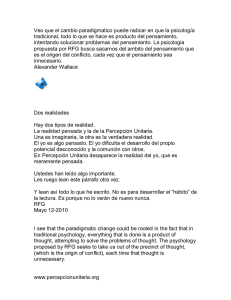Dichos hechos realidad - Houghton Mifflin Harcourt
Anuncio

Nivel: N EDL: 30 Género: Cuentos divertidos Estrategia: Preguntar LESSON 6 TEACHER’S GUIDE Dichos hechos realidad Destreza: Secuencia de sucesos Número de palabras: 843 by Lee S. Justice 3.2.1 Fountas-Pinnell Level O Humorous Fiction HOUGHTON MIFFLIN Libritos nivelados en línea Selection Summary Lidia wishes that idioms like “soltó la sopa” would mean just what they say. When her wish comes true, strange things start to happen and idioms come to life everywhere. ISBN-13: 978-0-547-03705-9 ISBN-10: 0-547-03705-8 1033927 H O U G H T O N MI F F L I N 3_037059_LR2_1CV_sayings.indd 1 Number of Words: 882 15/04/2008 10:53:41 Characteristics of the Text Genre Text Structure Content Themes and Ideas Language and Literary Features Sentence Complexity Vocabulary Words Illustrations Book and Print Features • Humorous fiction • Third-person narrative • Organized chronologically over several days • Problem presented from the beginning: Desearía que las palabras fueran lo que realmente significan. • Idiomatic sayings • Humor in figuring out what expressions mean • Language shouldn’t always be taken literally. • Idiomatic expressions make language colorful and expressive. • Misunderstandings can be humorous. • Many examples of idiomatic sayings, such as Me he muerto de risa, todo oídos, nadie soltó la sopa, en un suspiro • Context clues reveal meanings of sayings • Several long sentences interspersed with short sentences • Split dialogue • Several words that might not be familiar. Examples: actuación, regalitos de cotillón, investigación • revolvieron, suspiró, soltó, parpadeó, zumbando • Several exclamations, such as Mmmm, Uf and Uy • Humorous art that visually “describes” the idioms. • Thirteen pages of text • illustrations on almost every page, many humorous © 2006. Fountas, I.C. & Pinnell, G.S. Teaching for Comprehending and Fluency, Heinemann, Portsmouth, N.H. Copyright © by Houghton Mifflin Harcourt Publishing Company All rights reserved. No part of this work may be reproduced or transmitted in any form or by any means, electronic or mechanical, including photocopying or recording, or by any information storage or retrieval system, without the prior written permission of the copyright owner unless such copying is expressly permitted by federal copyright law. Permission is hereby granted to individual teachers using the corresponding (discipline) Leveled Readers to photocopy student worksheets from this publication in classroom quantities for instructional use and not for resale. Requests for information on other matters regarding duplication of this work should be addressed to Houghton Mifflin Harcourt Publishing Company, Attn: Contracts, Copyrights, and Licensing, 9400 SouthPark Center Loop, Orlando, Florida 32819. Printed in the U.S.A. 978-0-547-32258-2 1 2 3 4 5 6 7 8 9 10 0940 15 14 13 12 11 10 09 If you have received these materials as examination copies free of charge, Houghton Mifflin Harcourt Publishing Company retains title to the materials and they may not be resold. Resale of examination copies is strictly prohibited. Possession of this publication in print format does not entitle users to convert this publication, or any portion of it, into electronic format. 3_322582_OL_LRTG_L06_Seeing_Sayings_SPA.indd 1 1/22/10 5:14:10 AM Dichos hechos realidad by Lee S. Justice Build Background Ask students what the expression “llueve a cántaros” means. Build interest by discussing other idiomatic expressions such as grande como una casa and salir volando. Read the title and author’s name and talk about the cover illustration. Tell students that this story is humorous fiction, so it is meant to be funny and entertaining. Point out that the “dichos” in the title will lead to some funny pictures in the book. Introduce the Text Guide students through the text, noting important ideas and helping with unfamiliar language and vocabulary so they can read the text successfully. Here are some suggestions: Page 2: Explain that this is a story about a girl named Lidia. Lidia is puzzled by some sayings she hears people say. Suggested language: Vayan a la página 2. En el segundo párrafo, Lidia oye que Rita dice: Me he muerto de risa con ustedes. Lidia está sorprendida porque no ve que nadie esté muerto. ¿Qué creen que quiso decir Rita? Pages 3-5: Explain that Lidia has a ticket that gives her three wishes. She wishes that things would mean what they say. Then her sister says that Lidia “soltó la sopa” about a surprise party. Miren el dibujo de la página 5. ¿Cómo saben que el deseo de Lidia se hizo realidad? ¿Qué quiere decir en verdad “soltar la sopa”? Pages 9–10: Explain that when something continues to happen, it keeps on happening. Más cosas extrañas continuaron ocurriendo. En la página 9, parece que los huevos se están friendo en la acera. ¿De qué tipo de clima podría estar hablando un dicho sobre huevos que se fríen en la acera? Page 14: En esta página, Lidia se ve feliz. Su boleto para pedir tres deseos está viejo, y los bordes están irregulares. ¿Estarán así por haberlos usado tanto? ¿Creen que sus deseos se hicieron realidad? Ahora, vuelvan al comienzo y descubran qué pasa con Lidia y sus tres deseos. Target Vocabulary clasificar – ordenar de cierta forma, por ejemplo, unos junto a otros, unos tras otros, p. 12 continuar – seguir haciendo algo, p. 10 rápidamente – a mucha velocidad, p. 10 coleccionar – juntar cosas del mismo tipo, p. 12 irregular – que no tiene siempre la misma forma, o comportamiento, p. 14 revolver – mover de manera desordenada, p. 5 como una flecha – moverse de repente y muy rápido, p. 12 orden – ubicación de las cosas en el lugar en que van, p. 12 Grade 3 2 Lesson 6: Dichos hechos realidad © Houghton Mifflin Harcourt Publishing Company 3_322582_OL_LRTG_L06_Seeing_Sayings_SPA.indd 2 1/22/10 5:14:11 AM Read Have students read Dichos hechos realidad silently while you listen to individual students read. Support their problem solving and fluency as needed. Remind students to use the Question Strategy questions before, during, and after their reading. and to ask themselves Discuss and Revisit the Text Personal Response Invite students to share their personal responses to the book. Suggested language: ¿Creen que las cosas que pasan en el cuento realmente podrían pasarle a alguien? Expliquen su respuesta. Ways of Thinking As you discuss the text, help students understand these points: Thinking Within the Text Thinking Beyond the Text Thinking About the Text • Lidia wishes expressions would mean exactly what they say. • It helps to realize that not all expressions mean exactly what they say. • The many examples of figurative language reinforce the idiomatic meanings. • Sayings make language more lively, interesting, and funny. • Each idiom is also pictured in the humorous art to show what would happen if figurative sayings became literal. • Sayings come to life for Lidia, and cause some strange situations. • Lidia wishes that sayings would go back to being just sayings. © 2006. Fountas, I.C. & Pinnell, G.S. Teaching for Comprehending and Fluency, Heinemann, Portsmouth, N.H. Choices for Further Support • Fluency Invite students to choose a passage from the text to read aloud. Point out that Lidia is puzzled and confused during much of the story. Remind them to read in a way that shows this feeling. • Comprehension Based on your observations of students’ reading and discussion, revisit parts of the text to clarify or extend comprehension. Remind students to go back to the text to support their ideas. • Phonics/Word Work Provide practice as needed with words and word parts, using examples from the text. Remind students to take apart and make words with a variety of endings from the story (conducía, encontró, imitando, tenía). Grade 3 3 Lesson 6: Dichos hechos realidad © Houghton Mifflin Harcourt Publishing Company 3_322582_OL_LRTG_L06_Seeing_Sayings_SPA.indd 3 1/22/10 5:14:11 AM Writing about Reading Critical Thinking Have students complete the Razonamiento crítico questions on Hoja reproducible 6.7. Responding Have students complete the activities at the back of the book. Use the instruction below as needed to reinforce or extend understanding of the comprehension skill. Target Comprehension Skill Sequence of Events Remind students that in a story, things happen in a certain order. Keeping track of when things happen will help them understand a story. Model the skill, using a “Think Aloud” like the one below: Think Aloud A Lidia se le cumple su deseo de que los dichos quieran decir exactamente lo que dicen. Miremos el cuadro. El primer dicho que ve Lidia es el que le dice su hermana sobre soltar la sopa. ¿Cuál es el próximo dicho que se hace realidad? Necesito volver atrás en el cuento para averiguar cuál es. Aquí está, en la página 6: “Agárrate del sombrero”. Practice the Skill Have students write three sentences listing other events in Seeing Sayings in the correct order. Writing Prompt: Thinking Beyond the Text Have students write a response to the prompt on page 6. Remind them that when they think beyond the text, they use what they know and their own experience to think about what happens in the story. Assessment Prompts • What is the first page of the story mostly about? • Which word in the last paragraph on page 2 means almost the same as hacerlo pasar? • Why does Lidia hold her breath on page 13? Grade 3 4 Lesson 6: Dichos hechos realidad © Houghton Mifflin Harcourt Publishing Company 3_322582_OL_LRTG_L06_Seeing_Sayings_SPA.indd 4 1/22/10 5:14:12 AM Responder DESTREZA CLAVE Secuencia de sucesos Copia el gráfico que está abajo. Luego escribe cada dicho que Lidia ve convertido en realidad. Escríbelos en el orden en que ocurrieron. Agrega cajas si las necesitas. 1. Lidia suelta la sopa. 2. 3. ¡A escribir! El texto y tú Escribe un párrafo sobre tu parte favorita de Dichos hechos realidad. Usa ejemplos del cuento para explicar tu elección. Lección 6 Nombre Fecha Razonamiento crítico 15 HOJA REPRODUCIBLE 6.7 Dichos hechos realidad Razonamiento crítico Lee y contesta las preguntas. 1. Piensa dentro del texto ¿Cuál es el primer deseo que pide Lidia? 3_037059_LR2_1OL_DICHOS_L06.indd15 15 11/21/09 9:18:33 AM Respuesta posible: Desea que el boleto se caiga al piso. 2. Piensa dentro del texto ¿Cuándo se da cuenta Lidia de que está viendo los dichos hechos realidad? Respuesta posible: Cuando ve huevos friéndose en la acera. 3. Piensa acerca del texto ¿Crees que las experiencias de Lidia la han cambiado de algún modo? Explica tu respuesta. Respuestas posibles: Es más consciente de los dichos y es posible que los use; nunca más deseará que las palabras sean lo que realmente significan. 4. Piensa más allá del texto ¿Por qué crees que el autor incluye los significados de los dichos en Dichos hechos realidad? Respuesta posible: Algunos lectores pueden no conocer los significados de los dichos, especialmente aquellos cuya lengua manterna no es el español. Hacer conexiones ¿Qué otros tres dichos has oído o leído? Explica el significado de cada uno. Escribe tu respuesta en tu Cuaderno de lectura. Lea las instrucciones a los estudiantes. Razonamiento crítico 9 Grado 3, Unidad 2: ¡Exprésate! © Houghton Mifflin Harcourt Publishing Company. All rights reserved. 3_352916RTXSAN_U02_CT.indd 9 Grade 3 5 8/13/09 10:34:47 PM Lesson 6: Dichos hechos realidad © Houghton Mifflin Harcourt Publishing Company 3_322582_OL_LRTG_L06_Seeing_Sayings_SPA.indd 5 1/22/10 5:14:14 AM Nombre Fecha Dichos hechos realidad Pensar más allá del texto Piensa en las siguientes preguntas. Después, escribe tu respuesta en uno o dos párrafos. Piensa en algunos de los dichos que leíste en Dichos hechos realidad, como “me muero de risa” y “soltar la sopa”. ¿Sería bueno o malo si la gente no usara dichos como estos? ¿Por qué? Justifica tu respuesta. Grade 3 6 Lesson 6: Dichos hechos realidad © Houghton Mifflin Harcourt Publishing Company 3_322582_OL_LRTG_L06_Seeing_Sayings_SPA.indd 6 1/22/10 5:14:18 AM Lección 6 Nombre HOJA REPRODUCIBLE 6.7 Fecha Razonamiento crítico Dichos hechos realidad Razonamiento crítico Lee y contesta las preguntas. 1. Piensa dentro del texto ¿Cuál es el primer deseo que pide Lidia? 2. Piensa dentro del texto ¿Cuándo se da cuenta Lidia de que está viendo los dichos hechos realidad? 3. Piensa acerca del texto ¿Crees que las experiencias de Lidia la han cambiado de algún modo? Explica tu respuesta. 4. Piensa más allá del texto ¿Por qué crees que el autor incluye los significados de los dichos en Dichos hechos realidad? Hacer conexiones ¿Qué otros tres dichos has oído o leído? Explica el significado de cada uno. Escribe tu respuesta en tu Cuaderno de lectura. Grade 3 7 Lesson 6: Dichos hechos realidad © Houghton Mifflin Harcourt Publishing Company 3_322582_OL_LRTG_L06_Seeing_Sayings_SPA.indd 7 1/23/10 5:47:59 AM Lección 6 Estudiante HOJA REPRODUCIBLE 6.10 Fecha Dichos hechos realidad Dichos hechos realidad Registro de lectura NIVEL O page 10 Selection Text Errors Self-Corrections Accuracy Rate Total SelfCorrections Más cosas extrañas continuaron ocurriendo. En el colegio, el Sr. Barrios habló sobre los temas para las tareas de investigación. —Escojan un tema que no sea muy extenso —dijo el Sr. Barrios—. No abarquen más de lo que pueden. La boca de Lidia se llenó rápidamente de comida. Sus mejillas se ensancharon. Trataba de tragar, pero no podía. Su boca estaba muy llena. Sabía a manzanas. “Mmmm”, se dijo Lidia. 11 —Iremos a la biblioteca a buscar temas interesantes en los que podamos hincar el diente —continuó el Sr. Barrios. “Es sólo un dicho”, trató de decir Lidia. Comments: (# words read correctly/97× 100) % Read word correctly Code ✓ lobo Repeated word, sentence, or phrase ® Omission lobo lobo Grade 3 Behavior Error 0 0 1 8 Substitution Code lodo lobo 1 Self-corrects lodo sc lobo 0 Insertion el 1 Word told T lobo lobo Error 1416118 Behavior 1 Lesson 6: Dichos hechos realidad © Houghton Mifflin Harcourt Publishing Company 3_322582_OL_LRTG_L06_Seeing_Sayings_SPA.indd 8 1/23/10 5:48:01 AM



